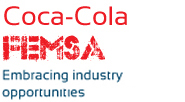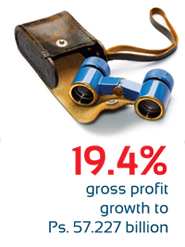


In 2011, our portfolio of franchise territories across Latin America delivered double-digit top- and bottom-line growth in the face of a challenging commodity cost environment and global market volatility. For the year, our total revenues rose 20.5% to Ps. 124.715 billion. Our gross profit increased 19.4% to Ps. 57.227 billion, and our income from operations increased 18.0% to Ps. 20.152 billion.
Profitable Complexity
Over the past several years, the complexity of our business has increased dramatically. At year-end 2011, our more than 85 thousand employees sold more than 2.6 billion unit cases to more than 215.6 million consumers through a network of 1.75 million points of sale across nine countries in Latin America. In contrast, before our acquisition of Panamco in 2003, our approximately 14,500 employees sold 620 million unit cases through a network of approximately 360 thousand points of sale across only three franchise territories in Mexico and Argentina. In order to properly operate and maximize the profit potential of this strikingly more complicated organization, among our other initiatives, we have developed a customer-centric commercial model, based on a multi-category beverage platform, supported by a customized, advanced information technology solution, which links our entire value chain—from production to distribution to the ultimate point of sale.
As part of our ongoing efforts to manage our large, growing, and increasingly complex enterprise with maximum operating efficiency and profitability, in 2011, we continued to evolve from a volume-driven to a value-driven commercial model to capture the full potential of the non-alcoholic beverage industry. Since 2010, we have converted close to 90% of our volume to our new Gestión de Valor del Cliente (GVC or Client Value Management) commercial model. This model segments our customers in the highly fragmented traditional sales channel into three distinct clusters—gold, silver, and bronze—based on their potential to generate value for themselves, our company, and the industry as a whole. Through this tool, we gain the flexibility to allocate our marketing resources more efficiently and effectively, capture additional industry revenues, improve the performance of our customers in the traditional sales channel, and lay the cornerstone for our company’s future organic growth.
Over the past several years, the complexity of our business has increased dramatically. At year-end 2011, our more than 85 thousand employees sold more than 2.6 billion unit cases to more than 215.6 million consumers through a network of 1.75 million points of sale across nine countries in Latin America. In contrast, before our acquisition of Panamco in 2003, our approximately 14,500 employees sold 620 million unit cases through a network of approximately 360 thousand points of sale across only three franchise territories in Mexico and Argentina. In order to properly operate and maximize the profit potential of this strikingly more complicated organization, among our other initiatives, we have developed a customer-centric commercial model, based on a multi-category beverage platform, supported by a customized, advanced information technology solution, which links our entire value chain—from production to distribution to the ultimate point of sale.
As part of our ongoing efforts to manage our large, growing, and increasingly complex enterprise with maximum operating efficiency and profitability, in 2011, we continued to evolve from a volume-driven to a value-driven commercial model to capture the full potential of the non-alcoholic beverage industry. Since 2010, we have converted close to 90% of our volume to our new Gestión de Valor del Cliente (GVC or Client Value Management) commercial model. This model segments our customers in the highly fragmented traditional sales channel into three distinct clusters—gold, silver, and bronze—based on their potential to generate value for themselves, our company, and the industry as a whole. Through this tool, we gain the flexibility to allocate our marketing resources more efficiently and effectively, capture additional industry revenues, improve the performance of our customers in the traditional sales channel, and lay the cornerstone for our company’s future organic growth.

Our more than 79 thousand employees produced, marketed, and distributed a multi-category beverage portfolio of more than one thousand products to over 215.6 million consumers throughout nine Latin American countries.








































